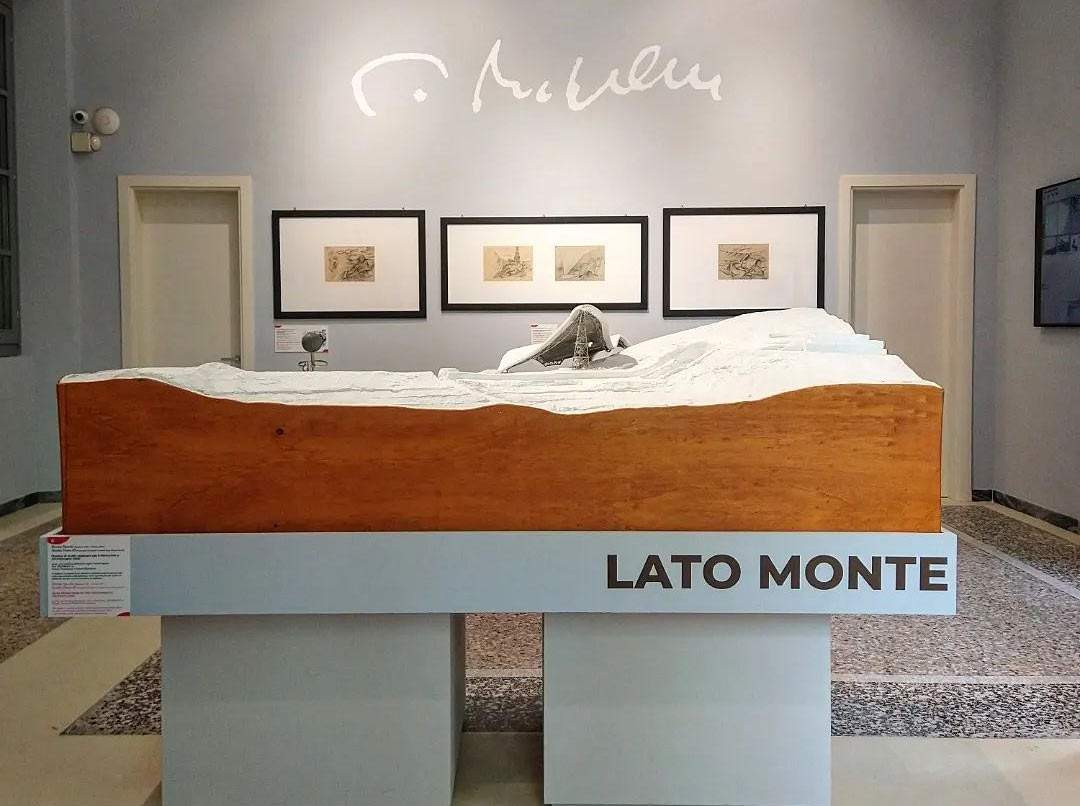Ongoing at the CARMI Museum in Carrara is the 1972 exhibition. Michelucci, Moore and Michelangelo. The Vitality of Marble, curated by Marco Ciampolini and Emanuela Ferretti. The exhibition is on view to the public until September 15, 2022. Four years after the opening of the CARMI at Villa Fabbricotti in Padula Park, the municipal administration of the city of marble is organizing an exhibition dedicated to the design affair of the Memorial in Honor of Michelangelo, promoted in the early 1970s, which saw the great architect Giovanni Michelucci (Pistoia, 1891 - Fiesole, 1990) involved. An anti-rhetorical celebration of the artist’s relationship with Carrara, the project was drawn up between 1972 and 1975 by Giovanni Michelucci, an outstanding figure in twentieth-century architecture. The Pistoiese master’s proposal, between architecture and sculpture, memory and transfer of knowledge, celebration of Carrara’s craftsmen and enhancement of the quarries, was to be enriched with the involvement of sculptor Henry Moore (Castleford, 1898 - Perry Green, 1986), a significant presence in the Apuan area since the 1950s.
The tale of an ambitious and imaginative dream, which was born in Carrara in the multifaceted cultural context of the 1960s-1970s, intends to acquaint the general public with a grandiose idea, evidence of a significant historical moment for the city and its territory. This project, conceived from a forward-looking perspective and marked by a close dialogue between art, architecture and science, can still provide a valuable opportunity for reflection on the present. Although unrealized, the Memorial to Michelangelo was the culmination of initiatives that started on the occasion of the fourth centenary of Buonarroti’s death (1964) and unraveled until 1975 (the anniversary of the fifth centenary of the artist’s birth), projecting Carrara into an international scenario.
The exhibition narrative unfolds over three thematic nuclei, identified by Professor Emanuela Ferretti: the development of the initial idea of a “monument” to Michelangelo by the Circolo Arturo Dazzi and its president Pierantonio Balli (1904-1987); the genesis and design path of Michelucci’s Memorial to Michelangelo, in all its articulations; and the focus, with unpublished materials, on Moore’s major anthological exhibition at Forte Belvedere in Florence (1972), as an evocative piece of the context of reference.
Through important loans, particularly of works that have never been presented to the public, the exhibition aims to restore the articulated and multi-year evolution of the project, also highlighting previously unseen connections between Michelucci’s graphic designs (of which a significant selection of the more than 150 drawings made is on display, along with the model of the project) and the works of Michelangelo Buonarroti, testifying to the architect’s close and fertile reflection on the master’s legacy. In this sense, the presence of Michelangelo’s Fluvial God in Michelucci’s study drawings (an icon of the exhibition) stands out, revealing the architect’s recognition of the consolidated didactic value of sculpture acquired over the centuries. This connection is evoked by the inclusion in the exhibition of the model of Michelangelo’s work, specially made on the occasion of its recent restoration (2017-2018).
The visceral relationship between Michelangelo and Carrara marble as well as the sense of the sublime of the Apuan scenery are motives of inspiration for Michelucci, and they resonate vibrantly in the forms of the project. Marble and its vitality are revealed in their inspirational valences through a selection of unpublished art photographs taken by Ilario Bessi (1903-1986), who was a direct witness and participant in the unfolding of events over the years.
The exhibition adopts diverse media: original drawings, prints, models, photographs and multimedia films. Specifically, video interviews performed for the occasion are presented, with professor emeritus Giorgio Bonsanti director of the recent restoration of the River God (2018), and architect Piero Micheli responsible for the staging of Moore’s 1972 exhibition. Adding to the latter is the recovery of an important video-document curated by professor emeritus Guido Spezza, produced during the exhibition by the University of Florence’s Experimental Cabinet for Film Research and now preserved in the Multimedia Laboratory of the University of Florence.
Complementing the exhibition within CARMI’s permanent museum itinerary are a series of sculptures, paintings and drawings, also unpublished or little-known, from the 16th-19th centuries, selected by Professor Marco Ciampolini with the intention of exemplifying the immense fortune of the master and his works: the display examines works of Michelangelo’s “inspiration,” from the 16th century onward, to paintings of a distinctly narrative tone, typical of the Romantic age, in which the rediscovery of the great artists of the past takes place through the telling of their biographical events. Exemplary, in this sense, are the paintings by the artist of “Nazarene” scope Peter Rittig(Pope Paul III Farnese visits Michelangelo in his studio, 1834), by Enrico Pollastrini from Livorno(Michelangelo discovers the David, signed and dated 1863) and by Filippo Bigioli from Marche(Vittoria Colonna visits Michelangelo’s studio, 1850).
Finally, of note is the process of enhancing the CARMI’s stable collection, which has been enriched with two 19th-century portraits of Buonarroti and an important painting by Antonio Puccinelli (1822-1897) depicting Michelangelo at the quarries (1864), permanently destined for the museum by the Provincial Administration of Massa and Carrara. It was precisely Puccinelli’s painting that was used in the 1975 international conference for the communication of initiatives related to the promotion of Michelucci’s Memorial project, and thus constitutes an ideal link between the two sections.
For all information, you can visit the official CARMI website.
 |
| An exhibition in Carrara on the visionary Michelangelo Memorial, a work by Michelucci that was never realized |
Warning: the translation into English of the original Italian article was created using automatic tools. We undertake to review all articles, but we do not guarantee the total absence of inaccuracies in the translation due to the program. You can find the original by clicking on the ITA button. If you find any mistake,please contact us.